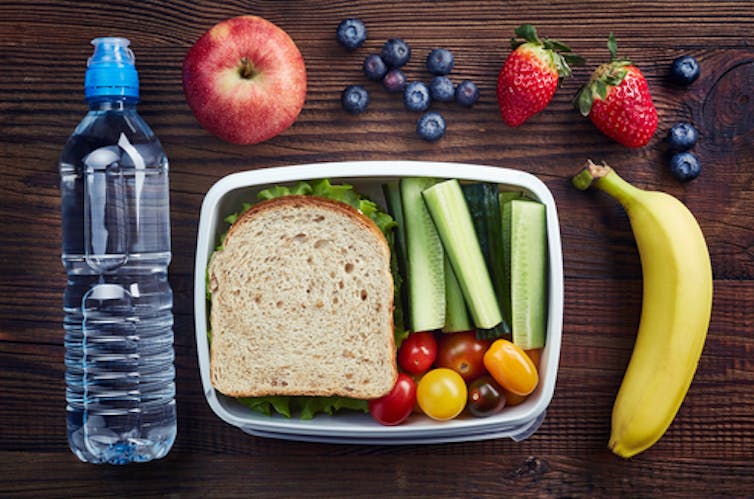Is there such a thing as a stress-free school lunch? Here’s how to pack one

baibaz/Shutterstock.com
Molly Paulson, Georgia State University
With the school year starting again, it’s time to start to think about the routine of packing school lunches. For many time-pressed parents, this is a formidable task.
But it doesn’t need to be. I’m a registered dietitian and a clinical instructor, and I have a few easy suggestions. The first has to do with the food itself, and the others are about organizing the meal.
Packing a powerful lunch
Research has shown that a balanced lunch of complex carbohydrates and protein offers children energy and brain fuel to help them get through a day of learning. For the main course, pair a complex carbohydrate, such as whole grain breads, crackers, pasta, beans, fruit, milk and yogurt, with a protein as your child’s main course. Some examples include a turkey sandwich on whole wheat bread, beans with rice and salsa, peanut butter and jelly, tuna salad on crackers, yogurt and granola or cottage cheese with fruit.
When considering complex carbohydrates, look for three to five grams of fiber per serving. Two slices of whole wheat bread usually contains three grams of fiber or more. A piece of fruit is a good way to get in complex carbohydrates, satisfy a sweet craving and avoid sweets with added sugars. Keep in mind that research suggests children should eat less than 25 grams of added sugar per day.
Next, concentrate on selecting fruits and vegetables that are in season. The U.S. dietary guidelines recommend that school-aged children have at least two cups of fruit and three cups of vegetables per day. In-season fruits and vegetables, which are at their taste peak and are more abundant, are good choices. Choose fruits and vegetables that will not brown quickly or get smashed in the lunch bag.
Include a few snacks that your child can eat along with lunch or during snack time at school. Good snack choices include easy-to-open items such as granola bars, trail mixes, string cheese with a piece of fruit, individual yogurts or cottage cheeses, and pretzels and hummus. Be sure to check for added sugars in yogurts and trail mixes, keeping in mind the recommendation for less than 25 grams.
Do not forget hydration. A water bottle for the day along with milk or a low-sugar – 10 grams or less per serving – juice box or pouch is a good option. Many juice companies offer options that are lower in sugar or include a serving of vegetables blended in with 100 percent fruit juice.
The logistics of lunches

Impact Photography/Shutterstock.com
Start your kids off early by involving them in the planning and shopping for the ingredients needed to pack their school lunches. Allow young packers to grab the side items to go into their lunch, such as fresh fruit and granola bars, while you pack the main, more labor-intensive food items.
Utilize the time to role-model healthy nutrition by packing your lunch for work with your child. Set aside time in your daily routine for lunch-packing so that it doesn’t creep up during stressful times such as running out the door in the morning. Assembly lines are a fun way to involve the whole family in packing lunches. A job can be created for all ages and cooking abilities.
Invest in reusable lunch containers. They may have more upfront cost, but overall the containers reduce waste and save money otherwise spent on lunch baggies. Firmer plastic or glass containers can also help to prevent browning and smashing of lunch items. Kids can have an added allowance opportunity of cleaning out their lunch boxes and containers to have them ready for the next day!
When shopping for lunch items, shop in bulk for nonperishable items such as granola bars, crackers and snacks and look for buy-one-get-one-free deals at your local grocery store. If concerned about fruits browning or bulk items going to waste, consider the cost benefit of prepackaged items that have longer expiration dates and will not brown. Examples include fruit squeeze pouches, single guacamole or hummus packets, peanut butter packet and yogurts.
Do not feel like your child needs something different each day. School is often a stressful time, and the lunch period is usually 20 minutes or less with the focus being on little talking and more eating so that kids can get back to learning on a full stomach. Often, lunch is “comfort food” from home for kids, and they enjoy having a routine lunch that they can count on during their school day.
If shopping, preparing and packing lunches is too overwhelming, you cannot go wrong with the National School Lunch Program. Often, you can save money and have more nutrition than packing a lunch from home. Farm-to-school initiatives and better overall nutrition have made school lunches a healthy, affordable option for families. When considering the financial impact of packing lunch from home versus buying school lunch, be sure to fill out your federal eligibility application for free or reduced meal eligibility.
Molly Paulson, Clinical Instructor, Georgia State University
This article was originally published on The Conversation. Read the original article.























-

-
-
AmbieBambi said
- 30 Jul 2019
-

-
-
Blossom said
- 01 Sep 2018
-

-
-
mom265671 said
- 18 Aug 2018
-

-
-
mom160421 said
- 18 Aug 2018
-

-
-
mom93821 said
- 18 Aug 2018
-

-
-
Ellen said
- 18 Aug 2018

-

-
-
youngoldlady said
- 18 Aug 2018
Post a comment6:27 am
8:23 pm
11:20 pm
4:31 pm
-

-
-
mom93821 replied
- 20 Aug 2018 , 5:54 am
Reply6:39 am
4:26 am
12:52 am
-

-
-
Ellen replied
- 18 Aug 2018 , 4:21 am

ReplyTo post a review/comment please join us or login so we can allocate your points.